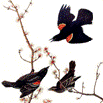Wildlife Damage Management, Internet Center for
Document Type
Article
Date of this Version
September 1966
Abstract
I'm going to move over onto poultry ranges, turkey ranges and hog farms where we have species of birds such as the herring gull, the pigeon, the starling and English sparrow. As a rule, these birds travel relatively great distances from roosts and loafing areas out to the feeding ranges. And why shouldn't they? There is ample high energy food available and usually lack of human disturbance. So they frequent these places during the daylight hours. Actually the losses from these operations are pretty hard to evaluate. Sometimes it is direct, the farmer feels the impact; other times it's indirect. We do suspect diseases being carried onto the poultry range or hog farm by these wild birds. Let's examine these four species and find where the damage occurs. I'll tell you what we are doing to reduce this damage. The herring gull, in this part of the country (midwest-Great Lakes) and also along the Atlantic Coast, is increasing in numbers by leaps and bounds. Also the herring gull has become a bum. In its original environment, it foraged along the shoreline and behind fishing vessels and it did very well. Now he's turned into a bum, because we've turned into bums. Our unsanitary ways of managing dumps and hog lots have made things ideal for the herring gull and he's adjusted very nicely to these conditions. Consequently, he's moved onto hog lots where they cook garbage and dump it onto the land. He also follows garbage feeding trucks through the hog lots where they dump cooked garbage into the feeding troughs. The gull is taking food from the hogs and from the farmer. Also because he visits the dump, then goes to the hog lot, he is also carrying such transmissible diseases as hog cholera. Also herring gulls are suspected of carrying TGE (transmissible gastroenteritis). Because they perch upon farm buildings, gulls are also adding to structural deterioration.


